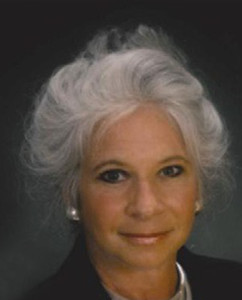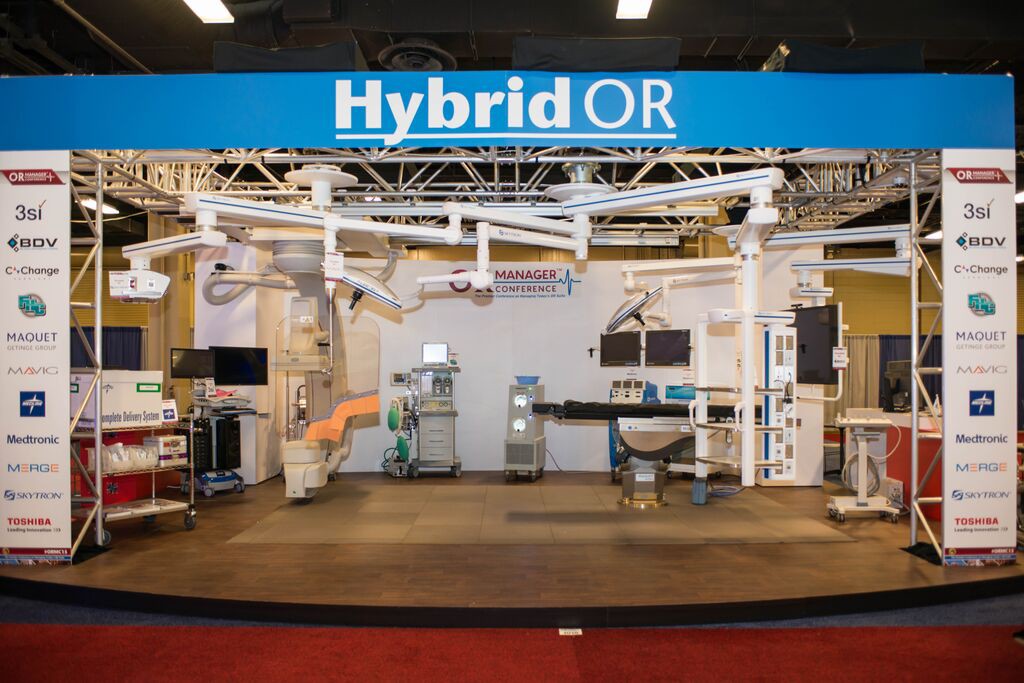The interactive hybrid OR, which debuted at the annual OR Manager Conference in 2014, grows larger and more comprehensive each year. For 2016, representatives from more than 10 different companies will be on hand to answer questions, and product demonstrations will create a dynamic learning environment.
The 2015 town hall meeting with members of the Hybrid OR Steering Committee has morphed into three 30-minute town hall sessions for 2016 to be held on Thursday, September 22. Each has a theme and will include time for questions from attendees.
Session one, "Learn From the Experts to Master Your First Build," will discuss the steps involved in creating a hybrid OR, including lessons learned and changes that have been made since those first hybrid ORs opened.
Session two, "Effective Collaboration–How to Avoid Having Too Many Cooks in the Kitchen," will explore how best to build synergy and a room that can accommodate a variety of different procedures.
In the last session, "Best Design Practices for Increasing Efficiency," speakers will review their planning processes and share what did and did not work. Questions about room and equipment specifications will be answered.
OR Manager asked committee members to answer some questions in advance of the conference. Here are their responses.
How do you secure support from hospital administration to build a hybrid OR?
"You must have a physician champion," says Cindy Kuperus, MBA, RN, CASC, director of perioperative services at Carson Tahoe Health in Carson City, Nevada. At her facility, that champion was an endovascular physician who worked with the preconstruction teams and staffing committees. "After several years, he is still involved in helping solve problems that arise," she says.
Identify key surgeons and interventionalists who will routinely be using the room," advises Tamara Mayne, BSN, RN, cardiothoracic surgery service specialist at the University of Colorado Hospital in Denver. "The better the physician buy-in and interest in a hybrid room, the easier it will be to get the hospital administration interested."
Mayne and several other committee members also say it's important to have a business plan. Patricia Seifert, MSN, RN, CNOR, CRNFA(e), FAAN, an independent cardiac consultant in Falls Church, Virginia, says OR managers must know the costs of devices and equipment as well as reimbursement rates so that they can incorporate the pros and cons into the business plan. Her advice:
• Develop partnerships with stakeholders, eg, staff from the OR, interventional cardiology, radiology, and anesthesia.
• Become familiar with healthcare care trends in the literature, including business and management; nursing, medical, and surgical; quality; and hybrid construction.
• Know the reimbursement rates for the procedures to be performed and how devices will be paid for.
• Find out who has the ear of administration.
• Collaborate with staff and trusted colleagues to identify potential problems and solutions before meeting with administration.
Being able to justify the need for a room is important, according to both Robert Maliff, director, applied solutions, at ECRI Institute, Plymouth Meeting, Pennsylvania, and Mike Hofmann, BSN, RN, director of perioperative services, St Elizabeth Hospital and Surgery Center, Appleton, Wisconsin.
"A typical hybrid OR can cost around $2 million just in equipment, so the operating volume should justify the cost," says Maliff. "If hybrid cases aren't enough, explore making it a flexible OR to handle other cases."
In Hofmann's case, the plan was to build a second cath lab. "Our cath lab volumes did not support the need for a second room, but we needed some kind of back up," he explains. "Our surgical volumes were growing, and we had solid justification to build another operating room. A hybrid OR was the perfect solution to support cath lab procedures and general OR needs."
How much planning time should you allow?
Answers to this question vary. Maliff says 4 months–in addition to the time for initial needs analysis–is the minimum needed to figure out imaging systems, workflows, lights and booms, and integration systems, whereas Hofmann puts the minimum figure at 6 months, with at least 3 months for staffing and operational planning.
According to Mayne, anything less than 1 year means the process will be chaotic. Stacey Berry, MSN, RN, CRNP, CNOR, NE-BC, clinical director of the OR at Susquehanna Health, Williamsport, Pennsylviania, and Kuperus feel more comfortable with a 12- to 18-month minimum.
"Do not rush any steps, or there will be mistakes. Mistakes are costly," warns Kuperus. The time line for her hybrid OR was as follows:
• December 2010, received first quote
• October 2011, sought board approval
• July 2012, began construction
• December 2012, performed first case (6 weeks after the projected completion date).
"A couple of years is not unreasonable for planning; that allows time for vendor review, site visits, financial considerations, and construction needs to ensure that you are meeting the goals set by the group to serve the patient population," says Sharman Lisieski, BS, RN, CNOR, director, OR/PACU, Saratoga Hospital, Saratoga Springs, New York.
Seifert emphasizes that the players involved will influence the time needed. "Do not assume that it'll be relatively easy, and do not put all the decision-making in the hands of those who do not have ‘skin in the game,'" she says. Think about how well the ultimate users of the room know one another and how likely they are to work well together, she adds.
What steps would you recommend for planning a hybrid OR?
Committee members uniformly state that identifying the key players and making sure they're involved in the whole process is the first step.
"Physicians who perform cardiothoracic, cardiac, and vascular procedures; interventional radiology [IR]; nurse managers and frontline staff; and representatives from facilities, biomedical engineering, and information technology [IT] should be involved–along with vendors because their expertise is important to the process," says Maliff.
Hofmann recommends developing a steering committee that includes leaders from the OR and IR, administration, and providers. Mayne also advocates forming a steering committee that meets from the prebuild to postimplementation phases.
Berry says the business plan should define what specialties the room will serve. In her experience, the room can serve multiple specialties, but it works best if procedures are carefully coordinated.
"Ours serve [vascular] true IR/potential open procedures [true hybrid cases] in our suite first," Berry says. "We planned ahead and put in a perfusion boom, so we can use the room for open heart, and eventually TAVR [transcatheter aortic valve replacement] procedures. We also use the room for urology-combined procedures, such as insertion of a nephrostomy tube by a radiologist, followed by a urologist doing his part of the procedure."
At Saratoga Hospital, Lisieski says, "We defined hybrid as flexible OR space. Each of our 10 new ORs is integrated with a built-in visualization system whose displays are suspended from ceiling booms. We have anesthesia booms as well, which provide gas machine placement flexibility if we have to flip a room."
According to Seifert, one of the most important steps is to develop a collaborative environment and culture that will facilitate good patient outcomes and foster a happy staff. "Make staff an integral part of the planning and implementation," she says.
Kuperus offers the following checklist of items to consider:
• Planning: Which departments need to be involved? (infection control, IT, cath lab, OR, etc)
• Who will use the room, and who has priority to use it?
• How will the room be used?
• Block time efficiency
• Construction/budget
• Equipment
• Service contracts and repairs (downtime and use of cath lab)
• Marketing (host a limited open house, invite board members, use publicity)
• Staffing/training/cost center
• Postbudget planning
• Upgrades.
Mayne suggests a few other steps for ensuring a successful hybrid OR launch:
• Create staffing plans to safely staff the room, and specific orientation plans for OR staff vs interventional staff.
• Identify supplies that will need to be in the room to prevent staff from having to go to different areas for supplies.
• Plan to have at least one "dry run" case before opening the room with all key players, and develop contingency plans. "Many sets of eyes often catch different aspects that need to be remedied during a dry run case," she notes.
What do you recommend to determine the size of the room?
"You need to have an idea of what cases your room will support," says Hofmann. "All square footage is not the same. If you have a poor room layout or are challenged with building in an existing space, you may end up with space that is not functional."
The minimum size depends on how the room will be used, the equipment it will house, and the supply storage availability, Kuperus says. She advises building as large a room as possible, and Seifert notes that it's wise to plan for growth in volume. As for actual room size measurements, Maliff says typically 900 to 1,000 square feet is needed, plus at least 120 square feet for the control room. Mayne puts the minimum at 1,200 square feet, whereas Hofmann cautions that a room that size takes a lot of time to clean and turn over. "You don't want a room that is too big," he says.
What do you consider when deciding on the location of the hybrid OR?
If possible, it makes sense to locate the room near the specialties it will serve, says Berry. "Ours is located next to our cardiac ORs, and very close to the endoscopic procedures and cath lab rooms."
Hofmann agrees, noting that it's important to consider who will be the primary providers and what supplies and equipment they will need. "You don't want to constantly move and manage supplies and equipment," he says. "You also don't want to duplicate these expensive items."
Also consider the actual available space and the distance between the room and the blood bank, Mayne says. If the room is in the interventional area, what is the distance to the OR? Physical distances can have an impact on patient safety, she notes.
How do you handle integration of the tables, imaging systems, and audio-visual systems?
"The imaging system and table should have the ability to have common controls to control the carbon fiber top and surgical tops (if third-party tables are used), and you have to also be aware of collision detection for the table and the imaging system," Maliff says. "Early on, you should decide on the integration for audio/video to plan for conduit runs if you are using monitors other than the large monitor provided by the angio vendors. Also, what information do you want to display on the video monitors?"
Mayne notes that imaging system table tops are designed to work with certain systems. "Are you willing to sacrifice adaptability of the room for surgeon preference? Interchangeable table tops seem to offer the best versatility for a hybrid OR, but often are not the preference of the surgeons or interventionalists because of the slower speed when working with the fluoro system," she explains.
"It is very important that all key players participate in the decision," Seifert says. "Get advisors who know what is needed and who have a track record of accomplishing what they say they are going to accomplish."
Berry and Hofmann agree, noting that physicians "may not want all the bells and whistles." In Berry's case, an IR advanced x-ray technician provided valuable input about equipment the physicians would or would not likely use. For Kuperus, the cath lab manager was most influential in deciding whether to go with ceiling mount vs floor mount because her endovascular surgeon did not have a strong opinion.
How do you determine what imaging technology to have in the room?
Imaging needs depend on the procedures to be performed, and most hybrid ORs now use angio systems, according to Maliff.
"A single plane will suffice for cardiac and vascular cases, but a biplane is more useful for neuro and spine cases. Many angio systems also have 3D CT [three-dimensional computed tomography] construction ability as part of their software package," he says.
"The interventionalists and surgeons who will be using the room should collaborate to find the best system," Mayne says. "Is the room going to be used primarily for cardiac or vascular procedures? Every system has its advantages and disadvantages. It is very challenging to please everyone. Keep that in mind when weighing benefits of each product."
Seifert agrees: "What is the patient population likely to be? If the room will be used for different types of surgery (ie, non-hybrid cases), this needs to be considered."
Other things to factor in, she says, are whether the imaging technology serves both adult and pediatric patients and whether equipment for CT scans, magnetic resonance imaging, and the like must be available in the hybrid OR.
What do you wish someone told you before you started your first hybrid OR build?
Responses to this question range from equipment and space considerations to room use to human resources–an indication of just how many pieces make up the puzzle of building a hybrid OR.
For Hofmann, taking a project management refresher course would have helped, and perhaps that's a good starting point for anyone building or renovating a hybrid OR.
"Planning a hybrid room is very complex, so get all the vendors together early on," Maliff advises. "Map out your control room exactly the way you want it to be, and anticipate every case that you may do in that room."
Berry recommends doing a flow map of movement in the room for the specialties that will be handled in that space. "This will tell you where your booms need to move so they are placed correctly. Use booms with the smallest footprint and adjustability. Go big on the live monitors if you have the space."
Kuperus praises her colleagues who helped plan and implement the hybrid OR at her facility: "We have a wonderful cath lab manager who has a positive attitude and is always able to staff the hybrid room with all of the flexibility we need. Only one time in 3 years have we had to reschedule a surgery because cath lab staff were busy."
Still, Kuperus notes that some revision construction is underway, and she offers these lessons learned:
• Make sure your monitors on both sides of the OR table are aligned. "We have one that is off the anesthesia boom, so it does not reach far enough around the arm, which creates constraints," she says.
• Do you really need the camera on the wall? We have never used it.
• We did not install booms for equipment. They take up too much space and have limitations.
• If you can build in storage cabinets, do it.
• Save some budget money for equipment you forgot and small repairs that might be needed during the first 3 months of use.
• Think about how to clean all the high equipment (this question came up in a state survey).
"I wish someone had known to ask questions regarding staffing of the room, best practices, and standards used by other hospitals," says Mayne. "We overstaffed the room initially and gradually decreased the amount of staff in the room, making it more efficient and creating better use of hospital resources."
In Seifert's case, she says, "We built an early hybrid room, and the state of the imaging art did not lend itself to the flexible use of the room." She wishes the room had been configured to be more useful for non-hybrid cases.
Certain details that escape notice can be costly to fix, notes Lisieski. "We were so focused on the audio-visual integration, booms, and so on, that we put in a floor that didn't meet our needs. This cost thousands of dollars and had to be replaced before the room was a year old," she says.
Products in this year's interactive hybrid OR exhibit will be provided by these sponsors:
Platinum
• GETINGE GROUP, Toshiba America Medical Systems
Gold
• Bayer, MAVIG GmbH, Medtronic, STERIS Corporation
Silver
• C Change Surgical, GE Healthcare, NDS Surgical Imaging, Olympus America, Inc, Philips Volcano, Skytron.
We hope the expertise provided by these companies and the Hybrid OR Steering Committee members will help make your hybrid OR launch less daunting. ✥
To learn more, visit http://www.ormanagerconference.com/interactive-hybrid/.
–Elizabeth Wood








